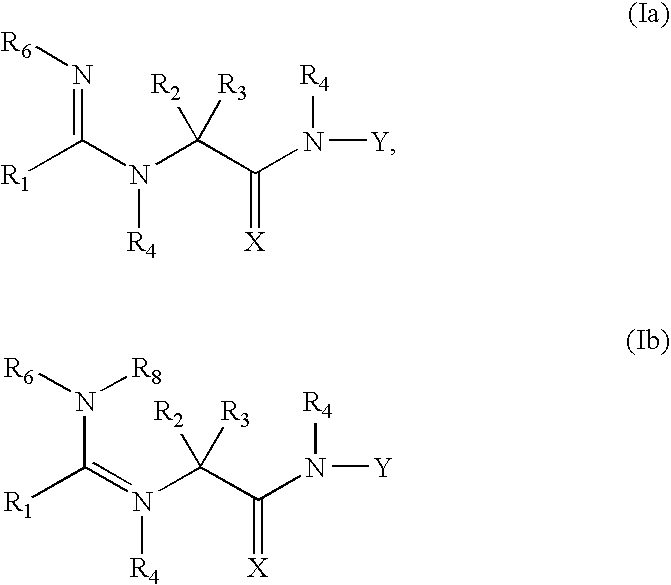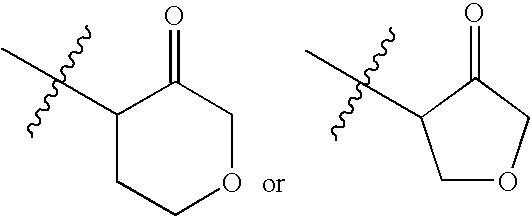Compounds useful as reversible inhibitors of cysteine proteases
a cysteine protease inhibitor and reversible technology, applied in the field of amidino and guanidino peptidyl compounds active as cysteine protease inhibitors, can solve the problem of increasing the likelihood of toxicity
- Summary
- Abstract
- Description
- Claims
- Application Information
AI Technical Summary
Problems solved by technology
Method used
Image
Examples
example 1
Synthesis of ((2S,3S)-3-amino-2-methyl-4-oxo-tetrahydrofuran hydrochloride salt
N-methylmorpholine (1.7 mL, 2.2 equiv) was added to a solution of (2S, 3S)-N-Boc 4)-t-butylthreonine (2.0 g, 7.0 mmol, 1.0 equiv) in anhydrous CH2Cl2 (40 mL). The resulting solution was cooled to −15° C. under an argon atmosphere. Iso-butylchloroformate (0.94 mL, 1.03 equiv) was added and the mixture was stirred for 20 min. A solution of diazomethane in Et2O (75 mL, about 67 mmol) was added over 5 min, the cold bath was removed and the reaction was allowed to warm over a 1 h period. Acetic acid was added dropwise until the bubbling stopped. The reaction solution was diluted with CH2Cl2 (150 mL) and washed sequentially with saturated sodium bicarbonate (2×100 mL), water (1×100 mL) and saturated brine (1×100 mL). The organic layer was dried over Na2SO4, decanted and concentrated in vacuo to yield (2S, 3S)-N-Boc-O-t-butyl-threonyldiazomethane as a yellow oil that was used without further purification.
A solut...
example 2
Synthesis of (S)-3-cyclohexyl-N-((2S,3S)2-methyl-4-oxo-tetrahydro-furan-3-yl)-2-(2-oxo-2H-benzo[e][1,3]oxazin-4-ylamino)-propionamide
(S)—N-Boc-cyclohexyl alanine (0.815 g, 3.00 mmol) was dissolved in 20 mL of dry THF. To this solution at 0° C. was added 4-methyl morpholine (0.55 mL, 3.00 mmol) followed by isobutyl chloroformate (0.64 mL, 3.00 mmol). This reaction mixture was stirred at 0° C. for 40 min. A suspension of ((2S,3S)-3-amino-2-methyl-4-oxo-tetrahydrofuran hydrochloride salt (Example 1) (455 mg, 3.00 mmol) and 4-methylmorpholine (0.550 mL, 3.00 mmol) in 10 mL of dry THF was added via a syringe. The reaction mixture was stirred at room temperature for 16 h. The solvent was removed in vacuo. The residue was washed with ethyl ether and dichloromethane. The solution was concentrated and purified by silica gel chromatography eluting with 3% MeOH in dichloromethane to give the desired amide (0.663 g, 60%) as a yellow oil.
The above amide (0.663 mg, 1.80 mmol) was dissolved in 2 m...
example 3
[1-[(S)-2-cyclohexyl-1-((2S,3S)-2-methyl-4-oxo-tetrahydro-furan-3-ylcarbamoyl)ethylamino]-1-morpholin-4-yl-meth(Z)-ylidene]-carbamic acid ethyl ester
(S)-2-Amino-3-cyclohexyl-N-((2S,3 S)-2-methyl-4-oxo-tetrahydro-furan-3-yl)-propionamide hydrochloride (See Example 2) (0.626 g, 2.06 mmol) was dissolved in 8 mL of dry dichloromethane. To this solution at 0° C., under nitrogen, was added ethoxycarbonyl isothiocyanate (0.30 g, 2.28 mmol) followed by triethylamine (0.48 g, 4.75 mmol). This mixture was stirred at 0° C. for 1 h. The solvent was removed in vacuo. The residue was purified by silica gel chromatography eluting with 0-50% EtOAc and hexane to give the desired thiourea (0.540 g, 71%) as an off white solid.
The above thiourea intermediate (0.10 g, 0.250 mmol) was dissolved in 5 mL of DMF. To this solution was added mercuric chloride (0.204 g, 0.750 mmol) and morpholine (0.065 g, 0.750 mmol). The reaction mixture was stirred at room temperature for 2 h. The solid was removed by filtr...
PUM
| Property | Measurement | Unit |
|---|---|---|
| bone resorption | aaaaa | aaaaa |
| osteoclastic bone resorption | aaaaa | aaaaa |
| resorption | aaaaa | aaaaa |
Abstract
Description
Claims
Application Information
 Login to View More
Login to View More - R&D
- Intellectual Property
- Life Sciences
- Materials
- Tech Scout
- Unparalleled Data Quality
- Higher Quality Content
- 60% Fewer Hallucinations
Browse by: Latest US Patents, China's latest patents, Technical Efficacy Thesaurus, Application Domain, Technology Topic, Popular Technical Reports.
© 2025 PatSnap. All rights reserved.Legal|Privacy policy|Modern Slavery Act Transparency Statement|Sitemap|About US| Contact US: help@patsnap.com



